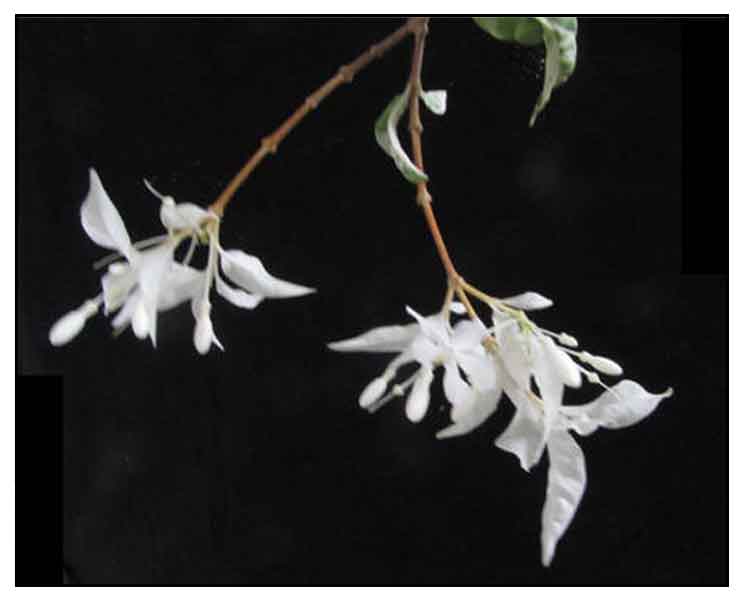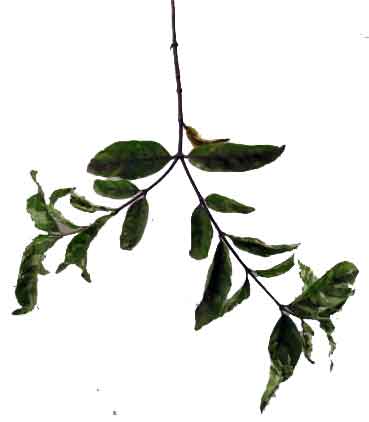 Botanical snippets Botanical snippets
- In Malaysia, water jasmine is the plant most often used for bonsai.(6)
- The genus was named for William Wright (1735-1819), a Scottish physician and botanist, by Robert Brown. (6)
Botany
Shui mei is a tropical shrub growing up to 3 meters tall. Bark is smooth and gray. Branchlets are thin, terete, often with many lateral and short branches, minutely puberulent. Petioles are 2 to 4 millimeters. Leaves are opposite, simple, elliptic, ovate or narrowly oblong, 2.5 to 7.5 centimeters long and 1.5 to 3 centimeters wide, pubescent along the mid-vein, with 5 to 7 paired lateral veins. Cymes are often on short, few-leaved branches, short peduncled, and 1- to 13-flowered. Flowers are fruity scented, pendant, borne along the twiggy branches. Sepals are ovate, about 1.5 millimeters. Corolla is white and glabrous; lobes ovate, about 7 millimeters, densely pubescent on both surfaces. Ovaries are free. Seeds are narrowly fusiform, about 8 millimeters.
 Distribution Distribution
- Introduced.
- Ornamental cultivation.
- Widely planted as a hedge tree in Southeast Asia countries.
- Native to Cambodia, Laos, Malaysia, Thailand and Vietnam.
- A common bonsai plant in Malaysia, Singapore, Vietnam, Taiwan.
Constituents
- Activity guided assay of a methanolic extract yielded eight compounds viz, kaempferol 3-O-α-L-rhamnopyranosyl-(1-6)-ß-D-galactopyranoside (1), kaempferol 3-O-α-L-rhamnopyronosyl-(1-6)-ß-D-galactopyranoside (2), two new flavonol glycosides (3,4) quercetin 4'-O-α-L-rhamnopyranosyl-3-O-α-L-rhamnopyranosy-(1-6)-ß-D-glucopyranoside (5), rutin (6), quercetin 3-O-α-L-rhamnopyranosyl-(1-6)-ß-D-galactopyranoside (7), and wrightiadione (8)
- Study reported a new class of secondary metabolites of the family Apocynaceae, benzoxazinoid.
A new benzoxazinoid glycoside, (2S)-2-O-ß-D-apiofuranosyl-(1->6)-ß-D-glucopyranoside (4) were isolated, along with 12 known compounds, including benzoxazinoid glycosides (1,3), simple aromatic glycosides (5-8), a lignan glycoside (9), flavonol glycosides (12-13), and a megastigmane glucoside (14). (11)
Properties
- A favorite bonsai tree because of its fast growth.
- Astringent.
-
Studies have shown ß-glucosidase activity, tyrosinase inhibiting, antioxidant, air-purifying properties.
Parts used
Bark, roots.
Uses
Folkloric
- No reported folkloric medicinal use in the Philippines.
- In India, bark infusion used twice daily as medicinal herb.
- Roots used to treat skin diseases.
Others
- Ritual: Sacred among Buddhists.
Studies
• ß-Glucosidase Activity: Study of crude extracts from different stages of three scented flowers (W. religiosa, Ervatamia coronaira and Gardenia jasminoides) were evaluated for ß-glucosidase activity. The highest level was found in Wrightia religiosa. Enzyme activity was increased significantly in open flowers. There is a good correlation between ß-glucosidase activity and scent emission from flowers and roots. (3)
• PAH-Degrading Bacteria in Plant Phyllosphere / Air Purifying Potential: Phyllosphere bacteria on ornamental plants were characterized based on its removal of polycyclic aromatic hydrocarbons (PAHs), the major air pollutants in urban areas. PAH-degrading bacteria were 1-10% of phyllosphere population consisting of diverse bacterial species--Acinetobacter, Pseudomonas, Mycobacterium, and uncultured bacteria. Phyllosphere bacteria on unsterilized leaves enhanced the removal of phenanthrene. In addition, there was also reduction of other PAHs such as acenaphthylene, acenaphthene, and fluorine. Results suggest a role for the phyllosphere bacteria on ornamental plants in the natural attenuation of airborne PAHs in urban areas. (4)
•
Naturally Occurring FANCF-Hes1 Complex Inhibitors: Fanconi anemia (FA) is an inherited anemia associated with bone marrow failure, progressive decline in hematopoietic stems cells, developmental defects and a predisposition to cancer. FANCF is one of the eight proteins in the FA core complex which is a key player in the DNA cross-link repair pathway. A screening HTS assay of a methanolic extract isolated eight natural occurring inhibitors, including two new flavonoid glycosides (3 and 4) from Wrightia religiosa. Compounds 3, 5, and 7 showed potent inhibition of FACCF-Hes1 complex formation. Compound 7 disrupted the FANCF-Hes1 complex more efficiently than the Hes1 dimer. (7)
• ß-Glucosidase Activity / Scent Production: In some flowers, aromatic compounds are stored as non-scented glycoside precursors in vacuoles. The removal of sugar moiety from these compounds was facilitated by the activity of ß-glucosidases in floral tissue and is correlated with scent production. Study evaluated crude extracts of three scented flowers (Wrightia religiosa, Ervatamia coronoria and Gardenia jasminoides). The highest level of ß-glucosidase activity was found in Wrightia religiosa. The enzyme was detected in closed buds and significantly increased in open flowers. (8)
• Antioxidant, Tyrosinase Inhibition and DOPA-Auto Oxidation Activity / Aerial Parts: Study evaluated ethanol extract of aerial parts for antioxidant property, tyrosinase inhibition, and DOPA- auto-oxidation activity. Phytochemical screening for total phenolics, flavonoids, and pigment content showed significant differences among various plant parts. The leaf extract showed highest phenolic content and antioxidant activity on DPPH assay. The petiole extract showed highest tyrosinase inhibition activity while the fruit extract showed best anti-DOPA auto-oxidation. Both antioxidant activity and tyrosinase inhibition were dose dependent. (9)
• Latex / Benzoxacinoids / Leaves: Study evaluated different organs and leaves of Wrightia religiosa and the stem bark of W. pubescens. Both yielded seven known compounds, all specialized metabolites from indolic and polyphenolic biosynthetic pathways. Leaves of W. religiosa yielded 3-indole D-apio-ß-D-furanosyl-(1->6)-ß-D-glucopyranoside (1) and benzouracil (2), The latex yielded blepharigenin (4). The isolated specialized metabolites did not contribute appreciably to the antioxidant properties of the plant extracts nor did it show noteworthy arti-feedant response of the insect pest Spodoptera littoralis. (10)
• Aromas: In a study of 12 floral aromatic plants aimed to determine the the appropriate method for extraction of aroma and to select certain aromas with relaxing effect, steam distillation was found suitable for Wrightia religiosa. (12)
Availability
Wild-crafted. |

![]()



 Botanical snippets
Botanical snippets Distribution
Distribution